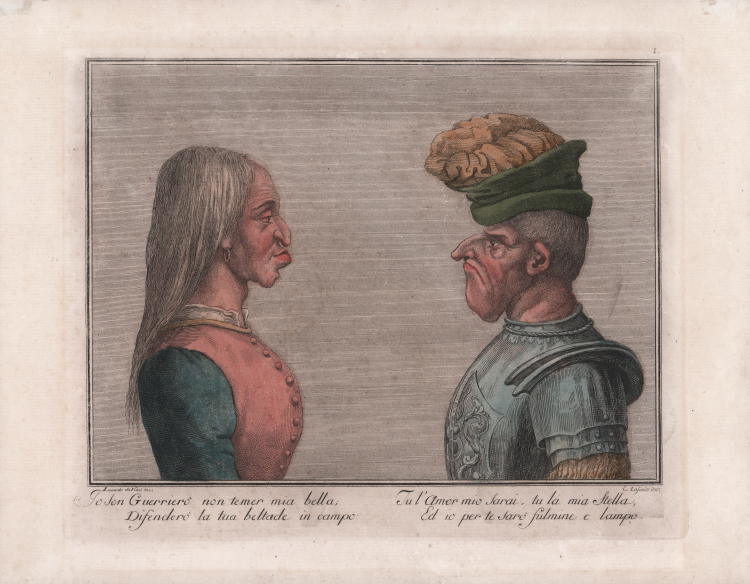




| Reference: | S46883 |
| Author | Carlo LASINIO |
| Year: | 1790 ca. |
| Measures: | 260 x 210 mm |



| Reference: | S46883 |
| Author | Carlo LASINIO |
| Year: | 1790 ca. |
| Measures: | 260 x 210 mm |
Io sono Guerriero non temere mia bella; Tu l’Amor mio Sarai, tu la mia Stella. Difenderò la tua beltade in campo: Ed io per te Sarò fulmine e lampo.
Etching, signed in plate C. Lasinio inc.
From a subject by Leonardo da Vinci.
Belongs to an amusing series of caricature portraits probably designed both to amuse the spectators of the time and as an urgent warning not to fall into the vices of folly and vanity. The depictions are based, in modified form, on Leonardo da Vinci's famous drawings of grotesque heads, now preserved in the collection of the Biblioteca Ambrosiana in Milan.
While Leonardo devoted himself with almost scientific meticulousness to deformations of the human physiognomy, Lasinio's works are dominated by a burlesque and moralistic element. The whimsical and mocking quatrains between the depictions criticize the inherent blindness of human nature to its own physical decay and its tendency to feign youth through ostentatious costumes.
This extremely rare series of caricatures is not described in any of Lasinio's catalogs raisonné of prints. It probably originally comprised a total of 12 sheets; 10 of these are in the Achille Bertarelli Collection in Milan. The coloring, coeval and barely preserved, makes the depictions particularly vivid.
Carlo Lasinio (Treviso 1759 - Pisa 1838), after studying painting at the Venice Academy, devoted himself to engraving, working briefly in his homeland. Around 1780 Lasinio was already in Florence, where he began his successful career as a reproduction engraver. He practiced all the traditional techniques of engraving - burin, etching, black manner, contour engraving - and successfully experimented with E. Dagoty-Le Blon's revolutionary system of using multiple plates inked with the colors red, yellow and blue that gave the impression of watercolor. He experimented extensively with this technique-which had already interested Bartolozzi as well-perfecting it and combining it with others and retouching some less successful parts by hand with a brush. With this chromatically effective technique, he reproduced the numerous series of etchings-more than 350 engravings-of the self-portraits preserved in the Uffizi, Ritratti de' pittori esistenti nella Reale Galleria di Firenze..., published beginning in 1789.
For Florentine publishers Niccolò Pagni and Giuseppe Bardi, he produced documentary images relating to the siege of Mantua by the French army. Again, for Bardi and Pagni in 1796 came out the collection of Costumes of the Peasants of Tuscany, in which the artist, author of the first eleven plates, used the system known as à poupée, a kind of pad for each color. In 1800 a portrait of Ferdinand III earned him an appointment as master of carving at the Reale Accademia of Florence.
Beautiful impression on contemporary laid paper, with margins, in good condition.
Bibliografia
Not in Cassinelli, Nagler e Le Blanc; C. Alberici, Leonardo e l'incisione. Stampe derivate da Leonardo e Bramante dal XV al XIX secolo, Milano 1984, pp.139-140, n. 202-204.
Carlo LASINIO (Treviso 1759 - Pisa 1838)
|
Lasinio started as a painter at the Accademia, Venice. He quickly placed more emphasis on printmaking, especially after moving to Florence in 1778. Lasinio moved to Pisa in 1807, taking up the position of conservatore of the Camposanto. He made considerable efforts to protect the Camposanto and its frescoes from ruin, from which it was threatened due to the destructive effects of the Napoleonic wars. In 1812 he began his influential book of etchings, recording the frescoes in the Camposanto. This was entitled, Pitture a fresco del Camp Santo di Pisa. These large etchings were composed in the sharply defined "outline style", which was popular in the early nineteenth century in reaction to the soft tonal effects of 18th century stipple engravers such as Francesco Bartolozzi. Other works depicting the old masters included his forty plates of Frescoes and Oil Paintings at Florence (1789), large etchings which delineated the most famous Renaissance frescoes in Florence; and thirty-two plates of Frescoes of the Fourteenth and Fifteenth Centuries.
Among his other activities Lasinio also founded the Academy in Pisa, where he died. Apart from his many series of engravings and etchings, Lasinio also created original images. His portrayals of eminent Italians include the great explorers, Christopher Columbus and Amerigo Vespucci.
His son, Giovanni Paolo Lasinio, was also an engraver.
|
Carlo LASINIO (Treviso 1759 - Pisa 1838)
|
Lasinio started as a painter at the Accademia, Venice. He quickly placed more emphasis on printmaking, especially after moving to Florence in 1778. Lasinio moved to Pisa in 1807, taking up the position of conservatore of the Camposanto. He made considerable efforts to protect the Camposanto and its frescoes from ruin, from which it was threatened due to the destructive effects of the Napoleonic wars. In 1812 he began his influential book of etchings, recording the frescoes in the Camposanto. This was entitled, Pitture a fresco del Camp Santo di Pisa. These large etchings were composed in the sharply defined "outline style", which was popular in the early nineteenth century in reaction to the soft tonal effects of 18th century stipple engravers such as Francesco Bartolozzi. Other works depicting the old masters included his forty plates of Frescoes and Oil Paintings at Florence (1789), large etchings which delineated the most famous Renaissance frescoes in Florence; and thirty-two plates of Frescoes of the Fourteenth and Fifteenth Centuries.
Among his other activities Lasinio also founded the Academy in Pisa, where he died. Apart from his many series of engravings and etchings, Lasinio also created original images. His portrayals of eminent Italians include the great explorers, Christopher Columbus and Amerigo Vespucci.
His son, Giovanni Paolo Lasinio, was also an engraver.
|